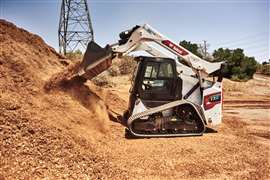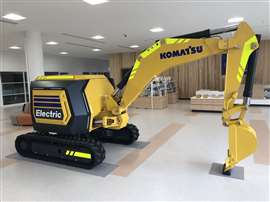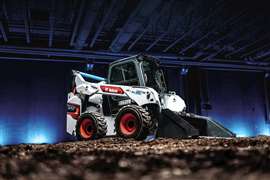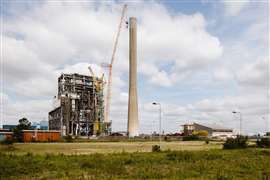Read this article in 中文 Français Deutsch Italiano Português Español
Future of construction machinery: Electric actuators vs. hydraulic
30 April 2024
 Bobcat’s all-electric T7X compact tracked loader (Image courtesy of Bobcat)
Bobcat’s all-electric T7X compact tracked loader (Image courtesy of Bobcat)
When Bobcat launched its T7X compact tracked loader just in time for ConExpo last year, it wasn’t only different in the sense that it was electrically powered.
More unusually, the machine also did away with hydraulic actuators in favour of electric actuators to make what Bobcat claimed was the world’s first all-electric compact tracked loader.
This wasn’t actually Bobcat’s first rodeo when it came to all-electric machines – the T7X followed the S7X, which the company claimed was the world’s first all-electric skid-steer loader.
And the American OEM isn’t the only company looking at the potential of electric actuators to make all-electric machines.
In 2022, Komatsu issued a technical paper studying a full electric mini excavator, with an electric motor instead of a diesel engine and an electric motor for all actuators. In the same year, it showcased a prototype fully electric compact wheel loader at Bauma in Germany, designed and built with Moog Inc.
What are the advantages?
In a world where hydraulic actuators are the norm on all sorts of construction equipment, why make the change to electric? And are they set to become a more common sight on construction machines of the future?
Perhaps one of the biggest arguments in their favour is that they are more efficient. Hydraulic actuators can involve big energy losses, and going all-electric can improve the overall efficiency of the machine, which helps to improve battery life if they are electrically driven. Komatsu’s all-electric mini excavator study found that the system efficiency improved from 30% to 57% compared to conventional hydraulic mini excavators.
There are other advantages, as Komatsu’s study points out, including doing away with hydraulic oil, which makes the machine more eco-friendly, as well as making it quieter.
The other argument in favour of electric actuators, as Joel Honeyman, vice president of global innovation at Bobcat Company, points out to Construction Briefing, is precision.
“When automotive started advancing electrification, we saw a lot of advances in components. When we take a look at these components, whether that is actuators or drives, you gain a lot in terms of feedback and position that you don’t necessarily get with hydraulics,” he explains.
“You get feedback on the current load that might be on the actuator itself but also on the position of the actuator and that has been a bit of a technical challenge with hydraulics for many years – knowing where the position is at all times,” he adds.
Operator’s perspective
From an operator’s perspective, they are unlikely to notice a major difference in the appearance of an all-electric machine or how it’s operated compared to a diesel-hydraulic machine, Honeyman asserts.
But it does have the potential to offer more accuracy and responsiveness.
That responsiveness can also be more easily controlled. “We have different settings that you can place on the vehicle and which we can change instantaneously to make it more or less
 A first look at Komatsu’s remote-controlled electric concept excavator
A first look at Komatsu’s remote-controlled electric concept excavator
responsive depending on the operator’s skill level – you can’t do that with hydraulics,” he says.
And electric actuators allow for the introduction of new features that hydraulic can’t necessarily accommodate.
“We put a feature on the machines where if you click a button, it automatically shakes out the bucket quite vigourously. The tilt actuator moves very rapidly to achieve that and you can’t do that with hydraulics,” says Honeyman.
Another new feature that electric actuators allow is automatic bucket levelling. “We know the position of the cylinder at all times and because of that we can automatically level the bucket without additional hardware,” he says.
The more extensive feedback that electric actuators provide also allows Bobcat to introduce safety features. “As soon as the bucket rolls all the way out on a loader, it can be in a vulnerable position for damage. So as soon as it is in that position we limit the current to the drive motors to prevent damage to the machine,” says Honeyman.
What are the limitations?
Nonetheless, there are limits to what electric actuators are currently capable of, particularly the force that linear actuators can apply.
That means it could be some time before larger equipment with linear actuators, such as excavators, see their hydraulic cylinders replaced with electric actuators.
Electric actuators tend also to take up more space, which can make it more challenging to fit them to machines.
“Today, a hydraulic cylinder is very compact. With electric actuation you need to have some input to be able to move it. In the case of our loader, that’s a ball screw actuator that has a separate motor on it and so the packaging is larger,” says Honeyman. “That’s one of the challenges of today but hydraulics solved that many years ago – they have been around a long time and they have been optimized. But as time goes along, automotive is continuing to put more technology into this area and I think we will see more solutions out there.”
As things stand, the technology is also more expensive than tried, tested and commonly used hydraulic solutions.
‘Just scratching the surface’
 Bobcat’s S7X all-electric skid-steer loader (Image courtesy of Bobcat)
Bobcat’s S7X all-electric skid-steer loader (Image courtesy of Bobcat)
Nonetheless, Honeyman sees a bright future for electric actuators. “I think we are just scratching the surface of it,” he says.
“A lot of our traditional hydraulic suppliers are now starting to work on electric actuation types of component solutions. The hydraulic supply base has woken up to the fact that this could be the new future and even on a diesel machine, there’s a lot of advantages. That means the component availability is getting better.”
“I would also be very quick to remind people that it doesn’t have to be an all-electric vehicle to take advantage of some of the technologies that are going to be available when it comes to electric actuation and electric drives. We are starting to see all kinds of crossovers and parallels [with diesel machines], not just in construction but in agriculture as well.”
While all-electric machines are generally not yet commercially available, Bobcat’s T7X has already started rolling off production lines, with Sunbelt Rentals becoming the first customer to buy the new machines, in what could be a sign that more machines featuring the technology are set to hit the market in the future.
|
STAY CONNECTED


Receive the information you need when you need it through our world-leading magazines, newsletters and daily briefings.
CONNECT WITH THE TEAM











